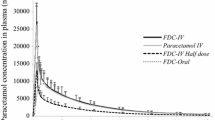Summary
The absorption, disposition, biotransformation and excretion of the nonsteroidal anti-inflammatory drug pirazolac were investigated in 6 volunteers (3 males, 3 females, age 50 > years) after intravenous and oral administration of 50 mg14C- p i r a z o l a c as an aqueous solution of the sodium salt.
Pirazolac was very rapidly and completely absorbed and bioavailable when orally administered in a dose of 50 mg in solution. Maximum pirazolac levels in plasma of 6 μg/ml (≙30% of dose in total plasma volume) were already reached after approx. 20 minutes. No metabolites were detectable in the plasma. Pirazolac was eliminated from the plasma in two phases with half-lives of 3 hours and 16 hours, respectively, regardless of administration route.
After intravenous and oral administration approximately 80% of t h e dose was excreted with the urine and approximately 15% with the feces within 7 days, indicating a complete excretion of l14C-radioactivity. In urine, approximately 10% of t h e dose was identified as unchanged pirazolac a n d 70% as pirazolac ester glucuronide.
Similar content being viewed by others
References
Biere H., Schröder E., Ahrends H., Kapp J.F. und Boucher I. (1982): Nichtsteroidale Entzündungshemmer. 5. Antiphlogistische Pyrazolessigsäuren. Eur. J. Med. Chem., Chim. Then,17, 27–34.
Bachmann F., Schorsch G., Geddawi M. and Matthes H. (1980): Clinical trial of a new non steroid anti-inflammatory compound in ankylosing spondylitis, SH K 376. Biol. Med.,2, 153–164.
Speck U., Wendt H., Schulze P.E. and Jentsch D. (1976): Bioavailability and pharmacokinetics of cyproterone acet a t e —14C and ethinylestradiol-3H after oral administration as coated tablet (SH B 209 AB), Contraception,14, 152–163.
Täuber U. and Weiss C h . : Determination of pirazolac in biological fluids by high performance liquid chromatography and fluorometric detection, (in preparation).
Poland H. and Woloszczak R. (1980): Program Library for computing the parameters of linear compartment models in pharmacokinetics. Int. J. Biomedical Computing,11, 115–128.
Willis J.V., Kendall M.J., Flinn R.M., Thornhill D.P. and Welling P.G. (1979): The pharmacokinetics of diclofenac sodium following intravenous and oral administration. Eur. J. Clin. Pharmacol.,16, 405–410.
Täuber U., Weiss Ch. and Matthes H. (1984): Pharmacokinetics of pirazolac — a new anti-inflammatory drug — in human volunteers. II. Dose linearity of plasma levels a n d excretion. Pharm. Res.4 (1985) in press.
Verbeeck R.K., Blackburn J.L. and Loewen G.R. (1983): Clinical pharmacokinetics of Non-steroidal Anti-inflammatory Drugs. Clin. Pharmacokinetics,8, 297–331.
Author information
Authors and Affiliations
Rights and permissions
About this article
Cite this article
Tauber, U., Weiss, C., Krause, W. et al. Pharmacokinetics of pirazolac — A new anti-inflammatory drug — in human volunteers I. Absorption, disposition, biotransformation and excretion. European Journal of Drug Metabolism and Pharmacokinetics 10, 41–53 (1985). https://doi.org/10.1007/BF03189696
Received:
Issue Date:
DOI: https://doi.org/10.1007/BF03189696




